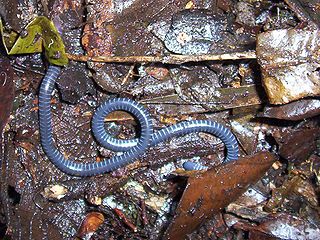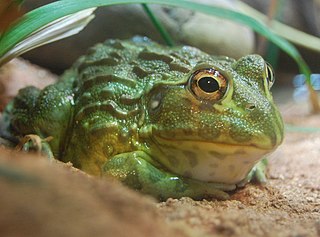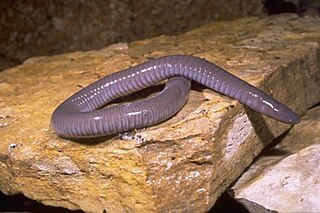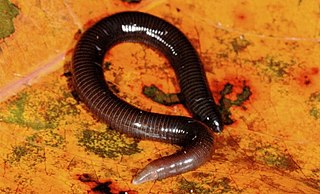Chikila fulleri, the Kuttal caecilian or Fuller's caecilian, is a species of caecilian endemic to India; the type specimen was collected six miles southwest of Silchar in Cachar, Assam, at an altitude of about 100 m above sea level. In 2012 it was reassigned to a newly erected family, Chikilidae. It is known only from northeast India, although it is expected to be found also in nearby Bangladesh and Myanmar.

Ichthyophis orthoplicatus, also known as the Pattipola caecilian or brown caecilian, is a species of caecilian endemic to Sri Lanka. It is found in a range of natural and man-made habitats including evergreen forests, rubber and tea plantations, paddy fields, rural gardens and farms, wetlands, and cattle pastureland.

Boulengerula is a genus of amphibians in the family Herpelidae. They are found in East Africa. They are sometimes known as Boulenger's caecilians or Usambara bluish-gray caecilians.
Boulengerula changamwensis, the Changamwe caecilian, is a species of amphibian in the family Herpelidae. It is also known as Changamwensis African caecilian and Changamwe lowland caecilian. It is found in southern Kenya and Malawi, and possibly in the intervening Tanzania and Mozambique.
Boulengerula denhardti is a species of amphibian in the family Herpelidae. It is endemic to Kenya. It is only known from its type locality, the Tana River valley, as well as from the Ngaia Forest, Meru County. It is named for German explorer brothers Clemens Denhardt and Gustav Denhardt who explored the area where it was discovered. Its natural habitats are subtropical or tropical moist lowland forests and heavily degraded former forest. It is threatened by habitat loss, expanding agriculture, use of herbicides and pesticides and expanding human settlements.
Boulengerula fischeri is a species of caecilian in the family Herpelidae. It is endemic to Rwanda and only known from around its type locality near Cyangugu, southwestern Rwanda. The specific name fischeri honours Eberhard Fischer, a German botanist who has worked with Rwandan fauna and flora. Common name Fischer's African caecilian has been coined for it. Live animals have the appearance of "live pink spaghetti".
Geotrypetes is a genus of caecilians in the family Dermophiidae, although some classifications place it in the family Caeciliidae. They occur in tropical West Africa and are sometimes known as the West African caecilians.
Herpele multiplicata is a species of caecilian in the family Herpelidae. It is endemic to Cameroon. It is only known from its holotype, which is now lost. The only available information is the brief species description published in 1912 by Fritz Nieden. Common name Victoria caecilian has been coined for it.

Herpele is a genus of caecilians in the family Herpelidae. They are endemic to Central and Western Africa.

Herpele squalostoma is a species of caecilian in the family Herpelidae. It is also known by the common name Congo caecilian. It is found in Central and extreme easternmost West Africa.
Sylvacaecilia is a monotypic genus of caecilian. The only species is Sylvacaecilia grandisonae, also known as the Aleku caecilian or Ethiopian caecilian. It is endemic to southwestern Ethiopia and known from the Gambela, Oromia, and Southern Nations, Nationalities, and Peoples' Regions.

Ichthyophis billitonensis, the Billiton Island caecilian, is a species of amphibians in the family Ichthyophiidae endemic to the Belitung island, Indonesia. Known only from the holotype, this appears to be a small species, measuring 135 mm (5.3 in) in total length. Habitat requirements are unknown but it probably inhabits moist lowland forests. It may be threatened by habitat loss caused by opencast tin mining.

Ichthyophis elongatus, the elongated caecilian, is a species of amphibians in the family Ichthyophiidae endemic to Sumatra, including some nearby islands; however, whether these belong to this species is uncertain.
Rhinatrema is a genus of caecilians in the family Rhinatrematidae. Their common name is two-lined caecilians. The genus is known from the Guyanas and adjacent Brazil.

The Pyxicephalidae are a family of frogs found in sub-Saharan Africa.

The frog family Dicroglossidae occurs in tropical and subtropical regions of Asia and Africa, with most genera and species being found in Asia. The common name of the family is fork-tongued frogs.

The Dermophiidae are a family of common caecilians. They are found in Central and South America, and Africa. Like other caecilians, they superficially resemble worms or snakes.

Hypogeophis is a genus of caecilians in the family Indotyphlidae. The genus consists of four species, all endemic to parts of the Seychelles Archipelago.
Boulengerula spawlsi is a species of caecilian in the family Herpelidae. It is endemic to Kenya and only know from the vicinity of its type locality, Ngaia Forest Reserve, in the Nyambene Hills, Meru County; the type locality is also spelled "Ngaya" or "Ngaja". The specific name spawlsi honours Stephen Spawls who first collected this species and who has contributed substantially to African herpetology. Common name Spawls' boolee has been coined for it.









